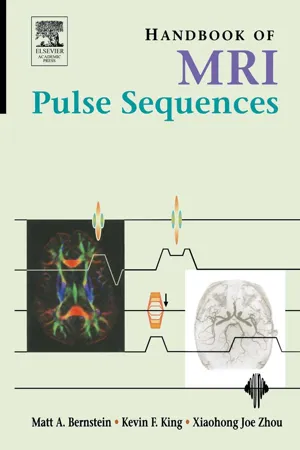
- 1,040 pages
- English
- ePUB (mobile friendly)
- Available on iOS & Android
Handbook of MRI Pulse Sequences
About this book
Magnetic Resonance Imaging (MRI) is among the most important medical imaging techniques available today. There is an installed base of approximately 15, 000 MRI scanners worldwide. Each of these scanners is capable of running many different "pulse sequences", which are governed by physics and engineering principles, and implemented by software programs that control the MRI hardware. To utilize an MRI scanner to the fullest extent, a conceptual understanding of its pulse sequences is crucial. Handbook of MRI Pulse Sequences offers a complete guide that can help the scientists, engineers, clinicians, and technologists in the field of MRI understand and better employ their scanner.- Explains pulse sequences, their components, and the associated image reconstruction methods commonly used in MRI- Provides self-contained sections for individual techniques- Can be used as a quick reference guide or as a resource for deeper study- Includes both non-mathematical and mathematical descriptions- Contains numerous figures, tables, references, and worked example problems
Frequently asked questions
- Essential is ideal for learners and professionals who enjoy exploring a wide range of subjects. Access the Essential Library with 800,000+ trusted titles and best-sellers across business, personal growth, and the humanities. Includes unlimited reading time and Standard Read Aloud voice.
- Complete: Perfect for advanced learners and researchers needing full, unrestricted access. Unlock 1.4M+ books across hundreds of subjects, including academic and specialized titles. The Complete Plan also includes advanced features like Premium Read Aloud and Research Assistant.
Please note we cannot support devices running on iOS 13 and Android 7 or earlier. Learn more about using the app.
Information
Table of contents
- Cover image
- Title page
- Table of Contents
- Copyright
- Dedication
- FOREWORD
- FOREWORD
- PREFACE
- PART I: BACKGROUND
- PART II: RADIOFREQUENCY PULSES
- PART III: GRADIENTS
- PART IV: DATA ACQUISITION, K-SPACE SAMPLING, AND IMAGE RECONSTRUCTION
- PART V: PULSE SEQUENCES
- APPENDIX I: TABLE OF SYMBOLS
- APPENDIX II: TABLE OF CONSTANTS AND CONVERSION FACTORS
- APPENDIX III: COMMON ABBREVIATIONS
- Index